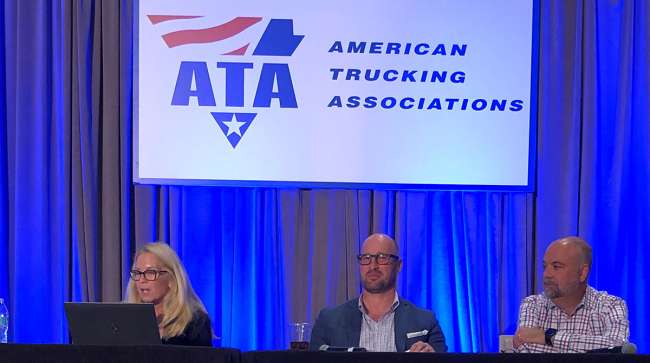Senior Reporter
Industry Faces Obstacles in Bid to Mitigate Driver Shortage

[Stay on top of transportation news: Get TTNews in your inbox.]
SCOTTSDALE, Ariz. — Accelerated retirements, an aging workforce, a decadeslong declining birthrate and low unemployment rate continue to cause challenges for the trucking industry as it seeks to overcome the 80,000-plus driver shortage.
Those were the conclusions from a panel discussion on the status of the labor market and the prospects for improvement at American Trucking Associations’ annual Mid-Year Management Session on May 15.
“In 2020 only, we trained significantly new drivers to the industry because of the pandemic and social distancing and some drivers left the industry,” ATA Chief Economist Bob Costello said. “The driver shortage hit a new high last year at just over 80,000. The trend line is not good, folks.

ATA banners greet attendees at the Mid-Year Management Session in Scottsdale, Ariz. (Zonar Safety & Compliance via Twitter)
If present trends continue, Costello’s 10-year forecast shows the industry needing at least 150,000 drivers, and that comes at a time when some experts say freight volume could increase 20% or more over an eight- to 10-year period.
“We could get to a point one day where we could be looking at empty shelves because of the driver shortage if we do not get this fixed,” Costello said.
But there are encouraging figures coming from the U.S. Department of Labor.
Costello said the industry added 15,800 employees in 2020 and an additional 6,800 in 2021. For the first quarter of this year, 5,400 have joined.
Even at a time when wholesale inflation is increasing at the highest level in more than 40 years at above 8% annually, the panelists noted that trucking companies are paying their drivers and staff increases that often are above the national rate of inflation.
We could get to a point one day where we could be looking at empty shelves.
ATA Chief Economist Bob Costello
The private fleet associated with Bentonville, Ark., retail giant Walmart recently announced it would begin paying its newest drivers up to $110,000 a year.
“We’re hearing from many of our partners that they are truly struggling to retain the existing staff they have and backfill their open positions,” The DDC Group Senior Vice President Donna Kintop said. “This hiring landscape is incredibly difficult and incredibly painful. It’s so important to keep the good people that they already have, and many companies are putting in retention plans to keep the people they have and that they are satisfied.”
Kintop said making it tough for all industries, including trucking, is that job candidates have more options, and before accepting job offers they are seeking higher salaries and benefits.
Many companies are putting in retention plans to keep the people they have and that they are satisfied.
Donna Kintop, senior vice president of DDC Group
While drivers must be on the road to do their jobs, Kintop said many trucking companies have changed their work policies for office staff, converting to hybrid schedules to remain competitive.
“There are many that have adjusted their work policies,” she said. “And they are developing talent for today’s culture and retraining their leaders to be more adaptable, along with upgrading their internal recruiting teams and make sure they’re up to date on the newest recruiting techniques.”
Andrew Boyle, co-president of Boyle Transportation, told the audience the traditional trucking industry, made up of private fleets, truckload and less-than-truckload carriers, faces competition for drivers at e-commerce delivery companies that often do not require drivers to have a valid CDL, because they are driving smaller vehicles or don't have to pass a drug test.
“If driving is your profession and you have the opportunity to do something in a smaller vehicle, you’re getting pretty good wages, and you have the opportunity to get overtime and you’re home every night, I feel that is very competitive to what we are offering,” Boyle said. “I think that is exacerbating the driver shortage.”
If driving is your profession and you have the opportunity to do something in a smaller vehicle, you’re getting pretty good wages.
Andrew Boyle, co-president of Boyle Transportation
Lifestyle also is a major consideration.
“I really believe that lifestyle issues today are at play here for longhaul trucking, more than they have ever been,” Costello said, discussing the desire many drivers say they have to spend more time at home and fewer overnights in their sleeper berths.
Boyle also pointed to the ongoing parking issue.
Data from the American Transportation Research Institute shows the average driver will spend 56 minutes during their 11-hour driving window looking for a place to park.

Host Michael Freeze discusses insurance coverage and costs with Jane Jazrawy of Carriers Edge and David Berno of Hub International. Tune in above or by going to RoadSigns.TTNews.com.
The panelists praised recent efforts by the Biden administration and the private sector to develop more driver talent by paid apprenticeship programs in which prospective drivers are paid by the company to undertake a training program before obtaining their CDL.
The U.S. Chamber of Commerce recently announced a program to recruit and train at least 500 separating members of the military to enter the industry.
Another program that should help, they believe, is the Federal DRIVE-Safe Act, which will allow new drivers ages 18-20 to drive interstate freight after undergoing an extensive training program.
It’s that type of innovation the panel believes will lead to more men and women entering the industry, especially as salaries hit levels never seen before.
“We’ve had a lot of these labor issues for a long time in the trucking industry,” Costello said. “It’s just the two years of the pandemic really brought them to the forefront.”
Want more news? Listen to today's daily briefing below or go here for more info:




